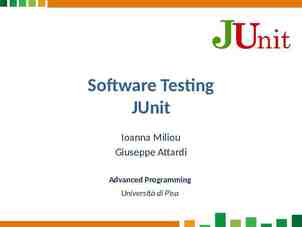A High Throughput Computing Analysis of Rounding in the Beer
20 Slides541.25 KB
A High Throughput Computing Analysis of Rounding in the Beer Distribution Game Nathan Patterson Dr. Jeffrey Rhoads Dr. Sangtae Kim [email protected] 04.22.2009
The Beer Distribution Game Four players Two week ordering delays Two week shipping delays Three week factory production
The Beer Distribution Game Exogenous Customer demand Goal of players is to minimize cost Illustrates nonlinear supply chain behavior – Bullwhip effect
Ordering Heuristic Single decision variable for each supply chain member John Sterman (MIT) – Data from 192 students playing the Beer Game Developed an Anchoring and Adjustment heuristic to mimic players’ behavior
Ordering Heuristic Four variables – – – – Expected demand updating rate (anchor) – θ (0,1) Stock discrepancy adjustment – α (0,1) Supply line discrepancy adjustment – β (0,1) Desired stock and supply line level – Q (12,17) Rounding methods – – – – No rounding, continuous variables Ceiling function Conventional rounding, nearest integer Floor function
Governing Equations DISt FOSt 1 DOSt min{DINVt 1 DISt 1 , DBLt 1 DIOt 1} DINVt max{0, DINVt 1 DIS t 1 DBLt 1 DIOt 1} DBLt max{0, DBLt 1 DIOt 1 DINVt 1 DIS t 1} FIOt DOPt 1 DEDt * DIOt 1 (1 ) * DEDt 1 DOPt max{0, DEDt s * ( DesINV DINVt DBLt ) SL * ( DesSupLine DIS t FIOt FBLt FOS t )} DOPt DED t S * (Q DINV t * ( DIS t FIO t FBL t FOS t ))
Response Identification Method Uses Euclidean distance to determine system states – – – – Constant-Valued Periodic Aperiodic Tolerance of 10-8 was used Allows code to stop when Constant-Valued solution occurs Test for periodicity if Constant-Valued solution does not occur within 100,000 weeks
Performance and Rounding Discrete- vs. continuous-valued implementations Metrics used to analyze different rounding techniques – Average steady-state operating cost ( 0.50 holding and 2.00 backorder costs) – Percentages of Constant-Valued, Periodic, and Aperiodic system responses
High Throughput Analysis Previous work investigated α-β space for specified θ and Q values Similar observations were made – – – – 1001x1001 (α-β) variable sets 4 rounding methods Separated into 1001 jobs 800mb data files ready within a few hours
Continuous Variable
Floor Function
Nearest Integer
Ceiling Function
High Throughput Analysis Expanded upon previous analysis – – – – – 201x201x201 (α-β-θ) variable sets Six Q values ranging from 12 to 17 Four rounding methods 194,894,424 variable possibilities Separated into 40401 jobs
Volumetric Analysis Q 17 Constant Valued Periodic Aperiodic Average Weekly Cost No Rounding 69.49% 6.31% 24.20% 91.89 Floor 61.69% 36.41% 1.90% 3,130.54 Round 66.36% 32.14% 1.50% 89.67 Ceiling 70.46% 28.20% 1.34% 81.14
Cost Ratio Analysis Holding and backorder costs can vary widely – Holding cost to backorder cost ratio analysis Holding Cost R Backorder Cost Ceiling function is best – When holding costs backorder costs Floor function is best – When holding costs backorder costs Conventional rounding for intermediate ratios
Rounding Summary High throughput numerical simulations allowed for observations of effects of rounding on solution types and system cost Rounding – the value of the Ceiling function – Largest constant-valued steady state regions – Lowest average operating cost Importance of cost ratio analysis – Used to determine rounding method if cost is priority Aggressive ordering is better Don’t need 100k weeks to study CV responses
Resources Used Used Condor high-throughput computing platform – On average used 1000-2000 computers on campus at a time – Lots of time spent transferring files – Used csh script to submit jobs Resources used to date – Over 4.5 million job submissions – 1,350,000 CPU hours ( 150 CPU years used!)
Acknowledgements Donald W. Feddersen Endowment Condor Project (www.cs.wisc.edu/condor) Rosen Center for Advanced Computing – Phil Cheeseman
Questions?

























